Hearing loss is one of the common health problems experienced by children and adults. Hearing loss can be a result of many different factors. It can be triggered by a blast of loud noise either in home or work environment, hereditary, or it can just be a part of the aging process. In addition, hearing loss can be caused due to infections, the effects of toxins or by injury. Globally, hearing loss affects about 10% of the population to some degree. Many researches had shown that approximately 1 to 6 infants out of 1000 births suffering from hearing problems ranging from moderate to very severe hearing level. (6)
Possible causes of hearing loss in children
Some children are born with hearing problems. More than half of hearing problems in children born with them are due to genetics. Others happen during the pregnancy or from prenatal care. Hearing problems that occur at birth known as congenital or after the birth of any time for reasons specific known as acquired. Other conditions that can cause hearing problems in young children, including illnesses such as meningitis, encephalitis, measles, chickenpox, and the flu. Head injuries, very loud noises, and certain medications can also cause hearing loss. Any severity of early hearing loss can be a serious problem. It can affect the language development, which experts believe is built during the early months and years of life. If diagnosed and treated quickly, the impact of hearing problems in babies and children can be reduced before they lead to any language problems. Below are the risk indicators of hearing loss in newborns.
Risk factors for hearing loss in infants and children:
| Risk indicators | |
| Family history * | Parental concern * |
| Ventilation > 5 hari | Ototoxic medication> |
| Hyperbilirubinemia | In-utero infection (CMV*) |
| Craniofacial anomalies | Associated syndrome |
| Neurodegenerative disorders | Meningitis * |
| Head trauma | Low APGAR scores (0-4 at 1 minute or 0-6 at 5 minutes) |
| Very low birth weight (<1.5 kg) | |
* Risk indicators that are marked with an asterisk are of greater concern for delayed-onset hearing loss.
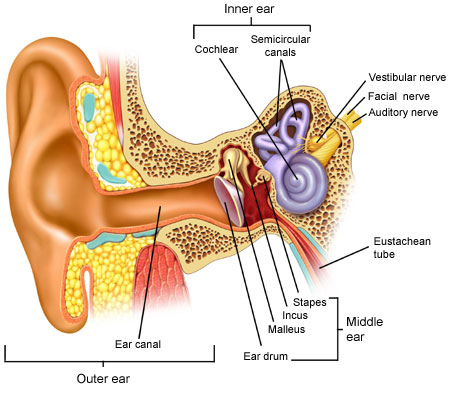 |
| Figure 1: Structure of ear (www.hearlife.com) |
|
Outer ear:
Middle ear):
Inner ear:
|
Classification of hearing loss
There are three main types of hearing problems; conductive, sensorineural and mixed hearing loss. Reasons to any hearing problems refers to any structure in the affected ear .
Conductive hearing loss
Conductive hearing loss – when hearing loss is due to problems with the ear canal, ear drum, or middle ear and it’s little bones (the malleus, incus, and stapes). Lists below are the possible reasons can cause conductive hearing loss;
- Abnormality of ear structure (Figure 2)
- Infection in the middle ear (Figure 3)
- Perforated eardrum (Figure 4)
- Foreign body (Figure 5)
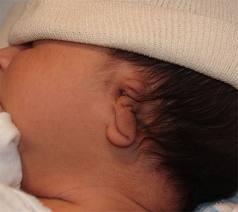 |
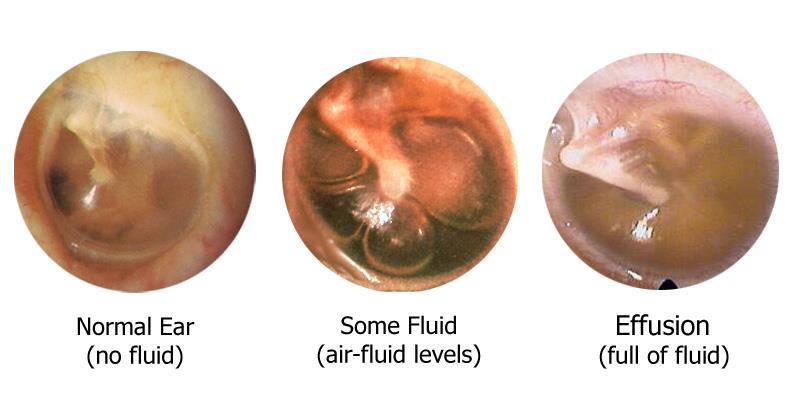 |
| Figure 2 (Stanford school of medicine) | Figure 3 (healthfavo.com) |
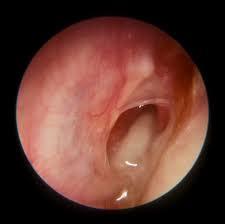 |
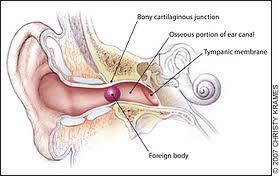 |
| Figure 4 (www.souuthlakeent.com) | Figure 5 (www.aafp.org) |
Otitis media
This middle ear infection happens often in young children because their Eustachian tubes (the tubes that connect the middle ear to the nose) are not fully developed. Fluid builds up behind the eardrum and can become infected. Even if there is no pain or infection, the fluid can affect hearing if it stays there, at least temporarily. In severe and long-running cases, otitis media can lead to permanent hearing loss.
Sensorineural hearing loss
There was a problem on the structure of the inner ear hearing organ either the cochlea or auditory nerve . Among the reasons for hearing loss is sensorineural ;
- Exposure to noise over a long period of time
- Head injuries
- Diseases
- Genetic / hereditary
- Age
- Ototoxic medications
Mixed hearing loss
Refers to a combination of conductive and sensorineural hearing loss. This means that there may be defects in the outer or middle ear and in the inner ear (cochlea) or auditory nerve.
Conclusion
There are many factors can cause hearing problems especially among children. It may be temporary (conductive) or permanent (sensorineural and mixed). Early identification of hearing problem and early rehabilitation will reduce the impact regarding hearing problem.
Reference
- C Wilson, A Roberts, D Stephens: Aetiological investigation of sensorineural hearing loss in children: Arch Dis 2005; 90:307-309.doi: 10.1136/adc.2004.049197.
- Denoyelle F, Marlin S, Weil D, et al.: Clinical features of the prevalent form of childhood deafness, DFNB1, due to connexin-26 gene defect: implications for genetic counseling. Lancet 1999, 353:1298-1303
- Irit Gruss, Mira Berlin, Tally Greenstein, Yaron Yagil, Michael Beiser. Etiologies of hearing impairment among infants and toddlers: 1986-1987 versus 2001. Int. J. Pediatr. Otolaryngol. (2007), doi: 10.1016/j.ijporl.2007.06.019.
- Joanne Roberts, PhD et al.,: Otitis media, hearing loss, and language learning: controversies and current research. Developmental and behavioral pediatrics. Vol 25, no.2, April 2004.
- Joseph W.Hall III, PhD, John H. Grose, PhD, Amelia F. Drake, MD, and Harold C. Pillsbury, MD: Developmental consequences of mild hearing loss. Current Opinion in Otolaryngology & Head and Neck Surgery 2000, 8:431-435
- Guidelines for High Neonatal Hearing Screening. Ministry of Health Malaysia
- Sanjay Morzaria, Brian D. Westerberg, Frederick K. Kozak: Systematic review of the etiology of bilateral sensorineural hearing loss in children. Division of Pediatric Otolaryngology, British Columbia Children’s Hospital, 4480 Oak Street, Vancouver, BC, Canada V6H 3V4
- Sokol J, Hyde M: Hearing Screening. Pediatr Rev 2002, 23:155-161.
- Windmill, IM: Universal screening of infants for hearing loss: Further justification. J Pediatr 1998, 133: 318-319.
- www.hearingloss.org
- www.hear-it.org/hearing loss
- www.medicinenet.com
| last Reviewed | : | 10 October 2016 |
| Writer/Translator | : | Norasuzi bt. Abdul Halim |
| Accreditor | : | Siti Suriani bt. Che Hussin |







